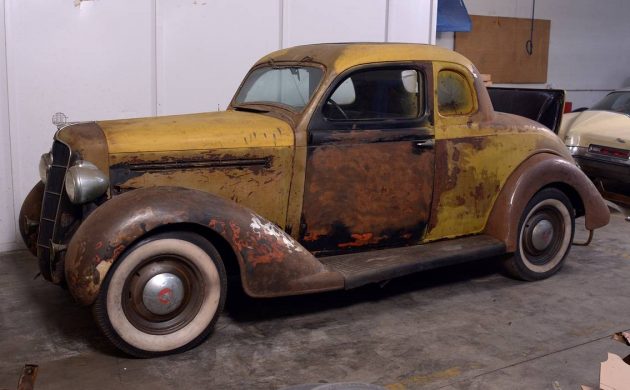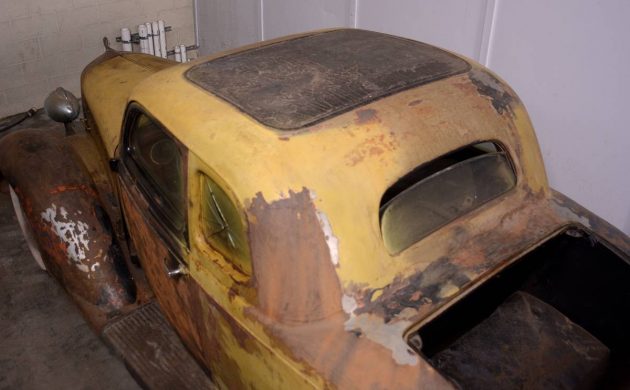Nobody is better at perusing classified ads for cars and dreaming up ways to squander what little money I have to purchase them. To justify the (usually) imaginary purchase, I assign a certain role for each car to play. For a car like this, I have always dreamed of restoring a moderately priced prewar coupe and driving it across the country. I call this Peter Egan syndrome, but with an American car focus. Thank goodness that prewar coupes have, until now, been slightly out of financial reach. Fortunately, or unfortunately as my wife would surely say, prices for solid prewar coupes have been trending downward. To give you an example, reader Ikey H. has found this well proportioned 1935 Plymouth coupe for sale on craigslist in White House, Tennessee. While needing work, the $12,000 asking price for this stored since the seventies coupe might be reasonable enough to fulfil my cross country dreams.
To expound on my idea, my goal would be to produce a car that was nearly all stock, reliable, comfortable, and capable of keeping up with traffic using period correct speed parts and modifications. While I love Fords of this era, Plymouths seem to sell for much lower amounts. The flathead six that they were equipped with is also a highly underrated engine. Produced until the 1970s as an engine for such things as airplane tugs and grove pumps, it is not hard to find a 230 cubic inch example to bolt into an early Plymouth such as this one. With tuning and some speed parts, 150 horsepower is possible. Paired with a later overdrive transmission, you could really motor on down the road in one of these 2,750 lb. coupes.
So, is this Plymouth a good candidate for such modifications and plans? First of all, this was a very good styling year for Chrysler’s low priced brand. The windshield was laid back a bit for this year, and the fenders became fuller in comparison to 1934 models. Deluxe models had chrome rings along the horizontal bars in the hood and a circular Mayflower hood ornament. This car curiously doesn’t seem to have rings, but does have the neat hood ornament. It also doesn’t have the steel artillery style wheels that were standard for both models. The car currently rides on steel rims common to later model Plymouths.
The elevated view in the picture above gives us a good look at the roof insert and rumble seat. It also gives us a better look at the bodywork that was started on this car. It appears that the car was headed for a simple re-paint at one time, but it likely ended up like most car projects once the owner lost interest. Despite the surface rust, the body and fenders appear to be free of rust through and quite useable. The lip on the body where the rumble seat closes looks as sharp as a tack. When you compare a car that was stored indoors to one less fortunate, details like this stand out. It is also surprising to see a roll down rear window in this coupe. I knew 1935 and 1936 Ford coupes offered this option, but was unaware that Plymouth did as well.
Peering inside, the car looks very presentable. The dash is complete, the gauges seem to be very useable, and even the steering wheel is free from cracks. The pedals need some help though. The clutch and brake pedal pads are missing, and the accelerator is flat to the floor. Otherwise, the dash and floor area look fresh from the factory. The door panels appear to be replacements, and the seta has the look of old vinyl. Some cleaning up would likely make the interior an area you didn’t need to spend money on right away. Not bad for a car of this age.
A glimpse of the engine compartment reveals why the accelerator pedal is on the floor. The car is missing its carburetor linkage. The good news is that this linkage system is easy to find, as the assembly changed little over the years. I am curious about the red painted head. Other Chrysler Corporation makes had higher compression heads, which were painted red, as an option. However, I have never heard of Plymouth offering such an option. At any rate, 1935 was the first year that Plymouth enclosed the water jackets on this engine. This car has that change, but I am unsure of this being the original engine. Many Plymouths got a block swap later in life to a more powerful later engine, so a closer look at the numbers stamped on the block would be the only way to verify originality.
Not that originality would matter if I somehow ended up with the car. The aforementioned plan is to swap it out to a later block with more cubic inches anyway. As for the rest of the car, I couldn’t live with the paint as it sits. Of course, that would mean I’d strip the car down and re-paint it. Then, I’d stuff an overdrive transmission from a 1950s Plymouth in, refresh the rest of the moving parts, re-cover the seats, insulate the interior… You get the idea. Once I got done I’d be a decade older, a lot poorer, and probably on to something else. It is nice to dream, and this car could be a real dream boat if given the proper care.
What would you do with it? Ever been on a cross country trip with an old car?










Drove my ’32 5 window from Mississippi to Oregon by way of Chicago in July one year. Windshield and rear window open, bag of water hung in front, cooler in the trunk. Great fun!
These sure were a stylish car, then along came Mr Keller and jacked up the roof to fit his hat. I can’t beleave the differance in this over the 1940 model posted here today. They look differant but there drive lines were unchanged. This would be a real head turner if restored and if I didn’t already have a project I’d be inclined to bid on this. Great find.
Thanks Swap in a slant six?
Convert to 12 volts with alternator, rebuild the engine to run on unleaded, install disc brakes, a collapsible steering column, three point harnesses, keep everything else looking stock as possible…..
As compared to the Model A, I think that this car has more style. I would love nothing more than do a cross country road-trip in an old 35′ Plymouth. I am assuming that there will be the argument between the purists and the modifiers as to what should be done with the car, but for the sake of practicality, I would drop a 318 with a vintage air unit in this car just so that it can keep up with traffic. It would also need some updates on the breaks as well.
I am so happy that the price of the pre-war cars are going down, it will allow an infusion of new car enthusiasts to get into the game and start working on projects that they are passionate about.
I’m a retired, bored car appraiser and live about 15 minutes from this one. If anyone is serious about it and wants me to take a look, be happy to (subject to weather).
<> in what?
$12,000 for that? With missing parts, and it doesn’t even run?
This is a restore type of car. The type you drive on the two lane back roads. With everyone on the interstate hiways they are pretty empty. I would love to drive a car like this down 281 in Texas or across US30 the old Lincoln hiway.
I love this car.
Stick a 318 in it.
Repaint it Viper yellow.
12 grand for a non runner ?
Not even half that
Amen Rick! Please folks, keep this one more or less original. Much as I love ’em, no 318s, no slant sixes, your Vintage air will run just fine on a flat-head 201. I have no problem with Vintage Air on my MGB/GT – with less than 100 cubic inches. I’m not a purist; a few tweaks to get some more hps out of the flat-head would be OK with me. Or did Chrysler build some larger-displacement flat-heads circa 1950 that would swap out easily and look practically identical. The sound of that flathead is as important as the looks of the car. ‘ Gotta keep it. Disc brakes OK, add overdrive (my dad’s ’37 DeSoto had factory Borg Warner overdrive – as did my ’53 Plymouth). With overdrive, you won’t spend a lot of time in the left lanes of the interstates, but at least you can stay out of the way. I do like those backroads though! Like US 50 across Nevada. ‘ Done it twice from Michigan to the west coast. But the fun of that is reliance on the vintage technology.
Surely, we can make a “better” car out of it, but at what point is it no longer a ’35 Plymouth?
FWIW…
I agree Allen, I have two MGA’s and have Vintage Air in both of them. With summers in Texas they way they are it is the only way to enjoy them year around. Other than that they are both bone stock.
Hey Rick. Do you know Art Zieske in Dallas? He used to make bits and brackets for bolting A/C compressor, etc into the MGA. One of my inspirations!
Hey! Rick. A shoutout from Balch Springs.
Doc
Haven’t seen an unrestored mid-30’s Plymouth coupe for quite awhile that wasn’t either a rust bucket or a cut up dirt track jalopy.
Looks like the same car that’s been showing up on Stacey David’s “GEARZ” t.v. show?
Never seen the show- but happen to know that the car is located in the same small town as his studio!
Yes it is! If you look closely you see the Buick he worked on in the show as well. If I remember correctly he didn’t exactly work on the car in the show, just explained how to start working on a barn find car.
Allen I don’t know Art directly but since Vintage Air in Fort Worth took care of everything for me I would not be surprised if he made some of the parts.
Hey Doc. Know Balch Springs pretty well. I retired from City of Dallas but I have lived down by Cedar Creek lake for years.
I find the style of this car very appealing. Mostly, I think, because of the compound curves of the body behind the roof. Beginning convex, then reversing aft of the rumble seat and down to the bumper mounts. Nice.
Not sure what path I’d take in bringing it to a roadworthy state, but for sure I like the road trip concept like @bobhess related. So cool.
Nice I have two a 35 and 36 bouth coupes desoto and a Plymouth . Running or not worth every cent remember if it not steel it’s not real. See you on rt 66 good luck and gods speed !,,,
Make an offer on the Riviera in the background. Yes, that’s a real hiway car not something that would leave you stranded because of some obsolete part.